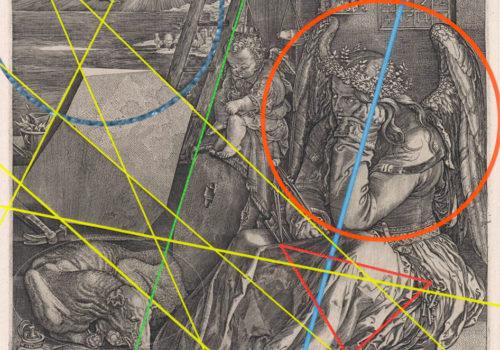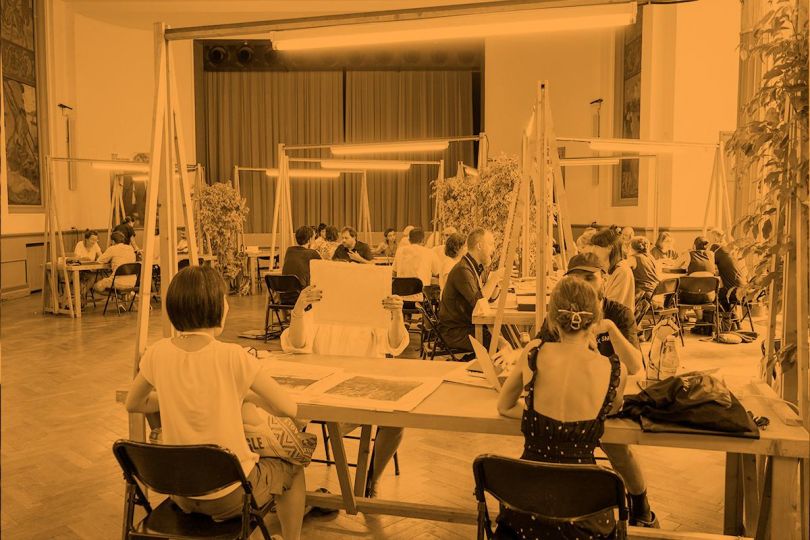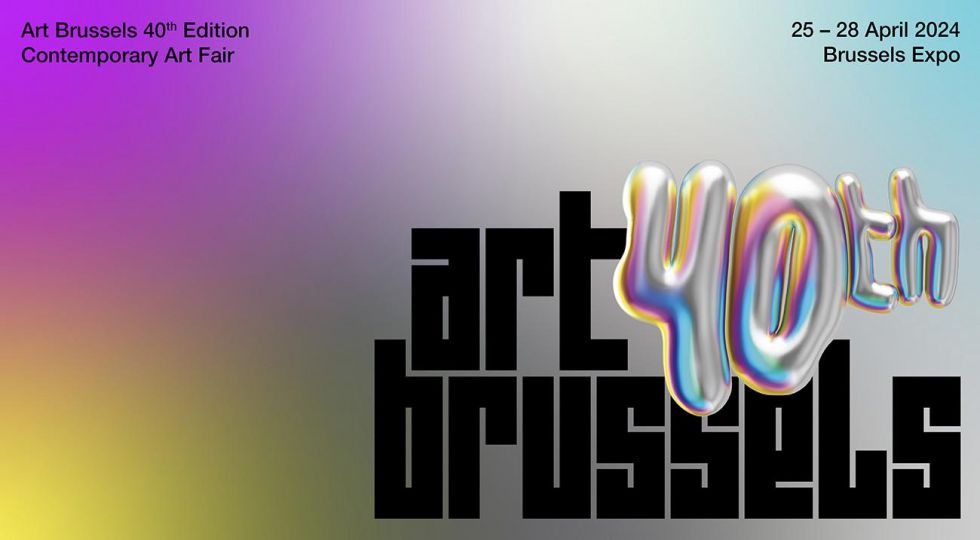BINOME – Laurence Aëgerter, Laurent Millet, Mustapha Azeroual, Thibault Brunet
Laurence Aëgerter (France 1972) (images 31- 32)
Laurence Aëgerter lives and works between Amsterdam, where she has lived since 1993, and Marseille. She is the winner of the Nestlé International Photography Prize at the Festival Images Vevey 2016 and the Prix du livre d’auteur at the Rencontres d’Arles 2018.
Aëgerter’s most recent series, Point de fuite, takes as its point of departure a double-page spread at the centre of Roland Barthes’ Empire of Signs, showing a photograph of a corridor in the Nijo Castle in Kyoto. The image is accompanied by a handwritten inscription of the author, echoed in the final sentence of the book: “Turn the image upside down: nothing more, nothing else, nothing.” Taking this injunction at face value, Aëgerter undertook to examine what happens to this image – and to three others taken from books on Japanese architecture – as well as to our reading of the image, when it is turned. A device attaching the image to the wall, as discrete as it is sophisticated, permits the viewer to rotate the frame on a central axis in four steps, as one would turn a dial.
Laurent Millet (France 1968) (images 33-34 )
Born in 1968 in Roanne, Laurent Millet lives and works in La Rochelle. He also teaches at the Ecole supérieure d’art et de design d’Angers (TALM). Nadar Prize 2014 for Les Enfantillages Pittoresques (Filigranes Editions), Niépce Prize 2015, member of the Casa de Velazquez (2007 to 2009), among other awards, his work has been the subject of numerous publications and exhibitions
Trained in contemporary art and photography, he combines his practice of photography with all the other arts: drawing, video, installation, and performance. Using several devices that he often combines, he builds a vocabulary that is situated at the limits of the visible and questions its relativity, between perception and imagination. Observatories, architectures, models, tools and measuring devices are recurrent in the artist’s work, contributing to the construction of what he calls a «measured reverie».
Mustapha Azeroual (1979, French-Maroccan) (images 35- 36)
“Considered as one of the rising stars of contemporary art in France” (Huffington post, Oct. 2015), Mustapha Azeroual (1979, French-Moroccan) is a self-taught photographer. A scientist by training, he bases his research on the observation of the processes of the apparition of the image and its manifestations, transmitted back to the spectator in the testing of the media of dissemination. Combining installation, volume and sequence with ancient photoengraphic processes, he actuates the historical techniques of shooting and printing, while opening up the field of investigation of the photoengraphic image beyond its presupposed limits (flatness and temporality). The question of the photographic and the materiality of the image is at the heart of his creative process.
The Radiance project aims to create an archive of light, and by extension of colour. At sunrise and/or sunset, two key moments of the day with regard to the chromatic variations of light, Mustapha Azeroual takes photographs of the same landscape with a camera. He takes several shots on the same film plane; negatives that he then assembles digitally. The making of the images, through this double superposition, transforms the landscape into an abstract form, and reduces it to a line. At the end of this synthesis, the artist retains four or five images that he transfers onto a single support, the lenticular, a technical process which, associated with movement, allows for a linked reading. Each movement of the viewer re-enacts the repetitive cycle of natural light. In a privileged relationship with the work, two people side by side can never perceive the same nuances. In this way, Radiance goes beyond the notion of the photographic moment, associated with the single image, to address the sequence in moving images. An experience of time, which Mustapha Azeroual combines with the experience of light as a synthesis of colours. Like these points of light at dawn and dusk, Radiance is a sensation, an image-experience stretched to infinity. Radiance #8 Finisterrae was realized in 2022 as is implicated in the name at the end of the world on the peninsula of Crozon (Brittany)
Thibault Brunet (1982, French) (images 37-38)
Thibault Brunet plays with the codified genres of photography to interrogate our relationship to virtuality in a society where the world is in the process of being entirely digitised. He first distinguished himself with series produced within video games, travelling in virtual worlds – Vice City, Lanscapes and First Person Shooter (2007-2013) – and Google Earth – Typologie du virtuel series (2014). Since 2016, with the series Territoires circonscrits, he has been working on the digitisation of the real world using a 3D scanner with the technical support of Leica Geosystem.
With 3600 seconds of light, Thibault Brunet captures the ephemeral beauty of clouds using a virtual space created in a video game. He observes the effect of the passage of time on the skies’ colors by creating a virtual sunrise and sunset cycle. He created a series of portraits of clouds modeled in 3D, illuminated by this sun, taking on different shades depending on the time of day. Thibault Brunet thus draws up a catalog of clouds, a typology of their shapes and changing colors. The images created by this project blur the distinction between painting and photography. The clouds appear to us as paintings. As we get closer, we realize that these images are simulacra created by a video game engine.
Binôme
19, rue Charlemagne,
75004 Paris
info(ad)galeriebinome.com
+33 (0)1 42 74 27 25
Bradwolff & Partners: Jaehun Park (South Korea, 1986) (images 39-41 )
Bradwolff & Partners is showing a solo presentation of Jaehun Park featuring his new LED objects. The artist reflects on the Earth’s fragility and advocate a future in which people and matter can establish new connections.
Jaehun Park deals with complex issues gripping the Earth. The fields of tension he explores question humanity’s attitudes that need to shift from ambiguous to activist. His practice is rooted in dismantling rituals within capitalism and consumerism. To do so, he normally uses video simulations that tell his stories as metaphorical objects in space
For Art Rotterdam, he allows these objects to manifest even further in a series of LED objects. By cutting elements out of their video-narrative and presenting them individually, he takes a new step in his development and confronts us with a narrative structure of the world we live in. Every little detail plays a role herein, and adding a sculptural dimension to an audio-visual quality only deepens his play with digital art.
Accordingly, he has chosen the work ‘Overheated Windmill’ 2021 to unravel the complex relationship between tourism and heritage. Windmills are now seen as a tourist attraction rather than an industry (as in the 17th century). Mills used for sawing wood ensured a flourishing shipbuilding industry in the Zaan region. Around 1650, approximately 75 ships were built here every year. These ships enabled the wealthy country to annex even more of the world for colonisation. Now we know that this entailed oppression, murder and other dishonest practices. This video work by Park shows how tourism now often revolves around objects that made colonialism possible. Jaehun Park lives and works in Amsterdam and Seoul.
bradwolff & partners
oetewalerstraat 73
1093 md amsterdam oost
06-513 999 54
info(ad)bradwolff-partners.nl
Contour Gallery : Saïdou Dicko ( 1979, Burkina Faso)(images 42-44)
Saïdou Dicko ( 1979) is a self-taught multimedia visual artist from Burkina Faso who engages in photography, videography, installation, and paintings. Coming from a Fulani background, he began his artistic pursuit from drawing shadows of his sheep. Later on in his career, those shadows became his focus and are present in all of his work. Originally having photography as his focal point, in recent years, he has expanded the approach to his creations and began to combine different media, where photography is incorporated with, for instance, paintings and digital collage.
Saïdou Dicko’s most recent series has been published in the photobook, “The Shadowed People”. The series is a combination of clichés, where he covers the subject with black paint. Being a reflection of his years of work, “The Shadowed People” aims to anonymise the subjects and subsequently break down the concept of the individual, democratising his characters by removing key societal indicators. At the same time, his art also gives a spotlight to his background not only through the black-inked figures, but also the four red squares grouped around a black one in the centre above the head of the subject in each photo. The formation represents the most prominent symbols connected to his Fulani origins, with the symbol being part of a typical traditional Fulani wall carpet. Poetic and poignant, Saïdou Dicko’s work aims to portray the shadow of stereotypes in which people of African backgrounds are living and the universality of their experiences.
To see how Dicko combined the different media in each artwork, we would like to invite you to see them in-person. Since Dicko’s works are photography that incorporates an analogue method of painting, each piece is unique. Half of the proceeds from the sales of his work go back to his family community: fifty percent of all sales go to his association, Nafoore Cellal, which has developed a health centre and pharmacy, an organic vegetable garden, two solar-powered water towers, and two manual water pumps in his native Yagma pastoral zone in Burkina Faso.
Contour Gallery
Josephstraat 164
3014 TX Rotterdam
info(ad)contour.gallery
Fred & Ferry : Jana Coorevits & Lydia Hannah Debeer
Jana Coorevits Belgium 1990 (images 45-47)
Jana Coorevits (1990) is a filmmaker and photographer. She studied audiovisual arts at Sint Lukas Brussels and works as an artistic researcher at the Royal Conservatory of Antwerp. Underlying her artistic practice is a detailed research into narrative techniques within literature, film and photography. Her artistic work takes place in an in-between space: an area where the boundaries between an inner world and the outer world blur and distinctions become diffuse. A mental landscape where images are not created through language and thought, but where images emerge from the space between words, between thoughts, the white space around ink.
Lydia Hannah Debeer Belgium 1992 (images 48-50)
Lydia Hannah Debeer is a Belgian visual artist and musician. Her practice explores the spaces in-between sound and image. She creates immersive landscapes through video, live and recorded soundscapes, and music.
Lydia Hannah’s work subtly unravels the different layers of reality, slowly revealing the cyclical interplay between absence and presence. By inviting timeless emptiness into space, Lydia draws out the fragility of landscapes, images, and sounds. Her work thereby mirrors the brittle duality of human existence, caught between the imaginary distance and the shapeless closeness of the real world. It lingers in the mind of the spectator, invoking the onlooker to be drawn after its estranging distance.
Fred&Ferry
Leopoldplaats 12
2000 Antwerpen
https://fredferry.com/
Galerie Bacqueville Thomas Devaux, David de Beyter, Marc-Antoine Garnier
David de Beyter France 1985 (images 51-53)
David De Beyter is an art photographer. His approach to photography is both conceptual and documentary. His artistic work is mainly based on the concept of landscape practice(s). He develops photographic, video and sculptural projects, presented in exhibitions as immersive spaces. He is a graduate of the photography workshop of La Cambre and of Le Fresnoy – Studio national des arts contemporains.
Marc-Antoine Garnier France 1989 (images 54-56)
Marc Antoine Garnier is a French photographer and visual artist who graduated from the Le Havre-Rouen School of Art and Design. His work focuses on “deconstructing” and “reconstructing” photography through a spatialization of this traditionally two-dimensional medium. He literally gives body to his images, taking as subjects the sky, the sea, the rocks or the vegetation. His photographs are objects that question the very nature of the image while taking us on a journey through the softness of natural phenomena such as the evanescence of clouds or the power of waves, highlighting their changing state.
Thomas Devaux 1980 France(images 57-59)
Thomas Devaux is a photographic artist who appropriates the colours used in marketing to complete his critical vision of the consumer world while giving us meditative, contemplative abstractions, where the subject – however trivial – melts into coloured and iridescent reflections. He plays with the codes of painting and photography to show us the evanescent idols of a world where the sacred has taken its place on the supermarket shelves.
Galerie Bacqueville
32 rue Thiers, 59800 Lille, France
Vlissingsestraat 239a, 4388 HC Oost-Souburg, Netherlands
www.galeriebacqueville.com
Galerie Caroline O’Breen : Anne Geene & Elsa Leydier
Anne Geene (The Netherlands, 1983) (images 60-62)
With the help of photography, Anne Geene investigates, collects and organises the world around her. She is known for capturing hidden patterns, beauty and humor in flora and fauna. She examines concepts such as possession, completeness, selection and desire. With a nod to the human urge to order and to know, her work graduates from collecting countless blades of grass or gradients of autumn leaves, to measuring the circumference of certain trees or birds according to the velocity of their droppings. The artist’s interpretation of her findings is strictly personal and refers to our urge to regulate and understand the world around us. At Art Rotterdam, Anne Geene will present large prints from a new project Fields of Grass and her newest developments of the series Eternal Herbarium. Fields of Grass consist of individually scanned blades of grass from a field in the direct surrounding of the artist. An ode to grass, the undervalued plant. Eternal Herbarium is a combination of preserved plant material and its photographic reproduction. In this way, an eternal comparison is created between the original colour (captured at the time of picking) and the fading organic equivalent. Anne Geene’s work is in numerous collections
Elsa Leydier (France 1988) (images 63-65)
Elsa Leydier’s (France, 1988) artistic practice revolves around the political charge of photography. Her recent series LUTOA (The Disobediences) is framed by ecofeminism and concerns the authorized deforestation of the Atlantic Forest. She echoes the recent spread of feminist street collages in which the word ‘luto’ is changed into ‘luta’ in black paint. In Portuguese, ‘luto’ means mourning and ‘luta’ means fight. Currently, only 8% of the surface which covered Brazil when the Portuguese invaded, remains. The construction of the new industrial port that is currently underway further destroys acres of forest and the seabed. With this project, Leydier speaks of the raise against such injustice and points at the connection of climate change with the economy. The artist highlights that the frames for her works were made in China. Even with the best environmental approach to materials, in a work calling out about an ecological disaster, Leydier demonstrates how the whole system is interlaced: materials from Latin America and a cheap labour force from Asia. In LUTOA (The Disobediences), Elsa Leyider questions whether the entire system, rather than the individual behaviours, should be destroyed in order to make a change. Elsa Leydier has a very impressive list of exhibitions.
Galerie Caroline O’Breen
Hazenstraat 54
1016 SR Amsterdam
The Netherlands
0647104484
galerie(ad)carolineobreen.com
John Devos
johndevos.photo(ad)gmail.com
















